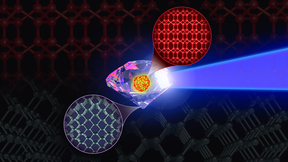Lab scientist wins Springer Thesis Award
 (Download Image)
(Download Image)
High Energy Density Science (HEDS) Center fellow Liz Grace works on the STRIPED FISH ultrashort pulse laser diagnostic. Grace recently won a 2023 Springer Thesis Award for her work in short-pulse laser physics. Photo by Jason Laurea/LLNL.
Elizabeth Grace, the High Energy Density Science (HEDS) Center Fellow at Lawrence Livermore National Laboratory (LLNL), has won a 2023 Springer Thesis Award for her work in short-pulse laser physics.
“I am very honored to receive this award from Springer Theses, and I look forward to publication,” Grace said. Her thesis will be published in a book series: Springer Theses: Recognising Outstanding PhD research.
Georgia Tech Physics Professor Rick Trebino, also her thesis adviser, and Tammy Ma, lead for LLNL’s inertial fusion energy initiative, nominated Grace for the award. She earned her Ph.D. from Georgia Tech in 2022.
“Liz’s Ph.D. dissertation is an example of outstanding and multidisciplinary research — both the development of a pioneering new laser diagnostic, and the direct application of it to advance ultra-intense laser-matter interactions. We’re proud to have hosted Liz here at LLNL for some of that thesis work,” Ma saud.
Grace’s thesis, “On-shot Spatiotemporal Laser Wavefront Characterization via Wavelength-Multiplexed Holography for Precision Control of High-Intensity Laser Plasma Interactions,” discusses the development of a single-frame laser characterization diagnostic, called STRIPED FISH, which she began working on as an LLNL summer student in 2019.
Short-pulse, high-intensity laser systems can be used to generate and probe extremely high-energy and density conditions of matter. The plasmas produced by these lasers can act as compact radiation sources, emulate astrophysical phenomena like supernova and centers of giant planets and even allow access to fusion regimes. Besides fundamental plasma physics, these ultra-intense laser-matter interactions also lend themselves to impactful scientific applications, including renewable energy, homeland security and state-of-the-art medical techniques.
“A continuing fundamental need in the field of laser-driven HED and plasma physics is the accurate and precise spatial and temporal characterization of the laser pulse that is responsible for these interactions,” she said. “Laser-plasma interactions are complex, rapidly evolving, and highly sensitive to shot-to-shot variations in laser parameters.”
Even under nominally identical laser conditions, small variations can drastically influence outcomes. However, most typical HED experiments currently do not measure the laser’s complete 4D electric field on-shot due to its complexity.
Her thesis covers the first use of STRIPED FISH on high-intensity, low-repetition rate laser systems onsite at LLNL’s Jupiter Laser Facility; its adaptation to high-repetition rate laser systems; its use in diagnosing and optimizing ultra-intense laser systems; and its role in developing a more complete understanding of the underlying laser-plasma interaction physics.
Springer is a global publishing company that publishes books and peer-reviewed journals in science, humanities, technology and medicine.
Contact
 Patricia Koning
Patricia Koning
[email protected]
(925) 423-4332
Related Links
Springer Theses: Recognizing Outstanding Ph.D. ResearchJupiter Laser Facility
Tags
High-Energy-Density ScienceLasers and Optical S&T
National Ignition Facility and Photon Science
Center for High Energy Density Science
Lasers
Featured Articles







